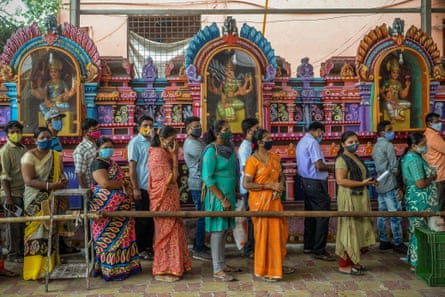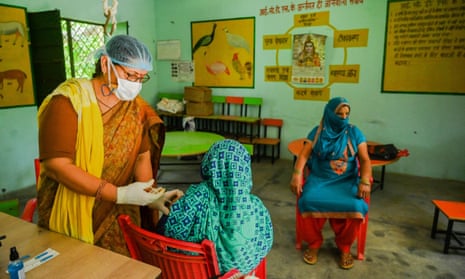Deep-rooted structural inequalities and patriarchal values are to blame for India’s worrying Covid vaccine gender gap, campaigners and academics have warned.
As of 25 June, of the 309m Covid vaccine doses delivered since January 2021, 143m were administered to women compared with nearly 167m to men, according to CoWin, India’s national statistics site – a ratio of 856 doses given to women for every 1,000 given to men. The difference is not accounted for by India’s gender imbalance of 924 women to 1,000 men.
Uttar Pradesh, India’s most populous state with the highest number of people living in rural areas, has administered 29m vaccines. Of this figure, which includes first and second doses, 42% were given to women. West Bengal, the fourth most populous state, is also lagging behind with women receiving 44% of doses. Dadra and Nagar Haveli, a predominantly rural union territory in western India, has one of the starkest disparities: just 30% of vaccines went to women. Daman and Diu, Delhi and Jammu and Kashmir are among the other regions performing badly. A handful of states, including Kerala and Andhra Pradesh, have given more doses to women than men.
Data on transgender people, non-binary people, or people of other marginalised genders has not been accurately tracked, with all groups falling under a singular category of “other”.
“Women are not seen as an important part of the family, community or society structure. [The vaccine gender gap] is reflective of the gender inequality prevalent in India, and even internationally,” said Bhagyashri Dengle, executive director of Asia Pacific and gender transformative policy and practice for Plan International.
Sofia Imad, a junior fellow at Mumbai-based thinktank IDFC Institute, has researched attitudes to vaccination among the urban poor population in Mumbai and Pune. She said there were a number of reasons why women were either unable or reluctant to get the vaccine.
“There is hesitancy because of rumours about side-effects, and how the vaccine affects fertility and menstruation,” said Imad. “But there are other factors such as women not being able to access the technology needed to register for it, not having information on where the centres are or not being able to go to the centres alone.
“Women often also need permission from their husbands to get vaccinated. Even if they get that, if their husbands are unavailable to accompany them … they miss out.”

Ram Kumari, 26, from Gurugram, Haryana, said: “I didn’t even know we had to register on the phone. I don’t have a smartphone. My husband has one, but I don’t know how to use it.”
She added: “I want to get the vaccine, and I thought of going to the government hospital, but it is too far to walk. I have no way of getting there, especially alone.”
The fifth National Family Health Survey, conducted in 2019–20, showed a clear digital gender divide. Of those surveyed, 58% of women had never used the internet, compared with 38% of men.
Julie Thekkudan, a women’s rights and gender justice expert with more than 18 years of experience, said: “Most men do not consider it important to register their wives on the CoWin app. Their health is not considered a priority and if they do not work outside the home then they are not considered at risk.”
She added: “Mobility also becomes an issue. If public transport is not easily available, and [the vaccination centre] is not walkable, what can working-class women do?”
Anecdotally, women report that men are given preference for getting the vaccination in many mixed-gender households. Neerja Sharma, 46, from Jaipur, Rajasthan, said: “My husband thought that it was right for him to get vaccinated first. Due to the possible side-effects of Covishield, he needed me to take care of him while he was sick. And if I got ill along with him, who will cook and look after the house and our son?”

Another concern for many women is that information on side-effects and how to deal with them is not readily available in an accessible language or format. There are also unfounded fears the vaccine could cause infertility, or interrupt menstrual cycles, particularly among rural communities.
Imad said: “A lot of the information that women get is through WhatsApp, which may not be reliable. Women have two kinds of concerns – one is that you cannot get the vaccine while menstruating, and the other that vaccination will affect your future cycles.
“Accredited social health activists haven’t been trained on the Covid-19 vaccines and haven’t been given any communications materials. They need access to community health worker materials so that they can alleviate concerns at the grassroots level.”
As companies prepare to go back to in-person working, getting vaccinated has become a priority for workers. A Covid-19 vaccination trends survey, conducted in India in April this year, found more than 50% of companies plan to facilitate vaccination for their employees and their dependents.
However, a study published in March by Krea University in Andhra Pradesh found that 93% of rural women and 77% of urban women are in informal employment, where most employers do not see it as their responsibility to ensure workers are vaccinated.
Earlier this month, the ministry of health and family welfare said anyone could walk in to a vaccination centre without preregistration on the app, making it more accessible for women.
But Thekkudan said more needed to be done to close the vaccination gender gap. “We need to encourage walk-ins and facilitate door-to-door vaccinations. We also need to create public health awareness materials, translated into regional languages and depicted pictorially. It is essential to put this vaccination drive into ‘mission mode’.”
Dengle of Plan International said it was not just an issue of access. “[We have to] address the social norms and root causes that create this gap. And it needs to start young: are we teaching our children stereotypes such as women belong in the kitchen? An inclusive curriculum is just one of the ways in which we can start addressing gender inequality which leads to such gaps in the larger scheme of things.”
